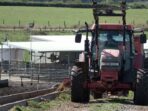How to Use Farm Waste to Improve Soil Health is like discovering the secret recipe for a garden salad that not only tastes good but also saves the planet! Imagine taking those leftover corn husks and turning them into a soil superhero that boosts your plants’ growth faster than a caffeinated rabbit on a mission. The more waste we recycle back into our fields, the healthier our soil becomes, and the happier our crops will be.
Let’s dig into the humorous yet practical world of farm waste management and soil health improvement, where every rotting apple and straw bale has a part to play in this agricultural comedy!
From composting to mulching, we’ll explore the various avenues through which farm waste can be transformed into an elixir for your soil, enhancing its texture and fertility. Not only will you be giving back to Mother Earth, but you’ll also be boosting your harvest while saving a few bucks along the way. So grab your gardening gloves and let’s turn that waste into the gold of organic farming!
Ah, the humble sock. A staple of modern life, a cozy companion for our feet, and the chief conspirator in what can only be described as one of life’s greatest mysteries: the disappearance of the left sock. You know the scene. You’re doing laundry, happily sorting through your pile of clothes as if you were a treasure hunter searching for the fabled riches of the laundry basket when—bam!—you pull out a lone right sock, staring back at you with the kind of judgment that could stop a clock.
The left sock? Gone. Vanished into the realm of the unknown, never to be seen again. Let’s embark on this whimsical journey to uncover the truth behind this enigmatic phenomenon.
The Sock Conspiracy: An Overview: How To Use Farm Waste To Improve Soil Health
We live in a world where socks have rights—rights to pair, rights to be worn, and rights to be comfortable. Yet, in the midst of this sock utopia, there exists a dark underbelly of sock-napping fiends lurking in the corners of our laundry rooms. Who are these nefarious sock snatchers? Could it be the mischievous washing machine, a rogue dryer, or perhaps even an ancient sock deity seeking to maintain cosmic balance?
One thing is for certain: they’re out there, and they’re armed with an unholy amount of static cling!
The Suspects
- The Washing Machine: The prime suspect in the Great Sock Disappearance. This mechanical beast seems innocent enough, gurgling and whirring in the corner, but who knows what goes on behind those metallic doors? Is it too far-fetched to think our trusty washer has an insatiable appetite for cotton? Perhaps it’s secretly hoarding socks like a dragon guards its gold? Just imagine, you open it up, and there it is—a treasure trove of mismatched socks, glinting in the light.
- The Dryer: Ah, the dryer—a master of disguise and a mischief-maker of the highest order. It has a PhD in fabric manipulation and an uncanny ability to shrink your favorite sweater. But the left sock? That seems to be its pièce de résistance. Could it be hiding in the dryer vent, plotting its escape to sock paradise?
Or is it simply too busy engaging in a game of hide-and-seek with the right sock?
- Pets: Let’s not forget our furry friends. Cats, dogs, and possibly even ferrets have been known to abscond with socks. Ever see a cat batting around a sock like it’s a prized mouse? Or a dog proudly trotting in with a sock that’s far too large for its mouth? It’s a sock-eat-sock world out there! The left sock could very well be the latest trophy in the ongoing battle for household supremacy.
- The Sock Monster: A classic suspect! The Sock Monster, a legendary creature said to exist in the depths of every laundry room, is the stuff of folklore. Some say it’s an amalgamation of lost socks that have banded together to form a creature of pure chaos. Others claim it emerges only during the full moon, dancing amid the piles of laundry in search of its next victim.
Socks beware—this cryptid has a taste for left socks, and it’s on the prowl!
The Sock Exchange Program
In an effort to combat this epidemic, some brave souls have fantasized about a Sock Exchange Program—an international initiative where left socks can be returned to their rightful owners. Picture it: a bustling marketplace filled with socks of all shapes, colors, and sizes, each waiting to be reunited with its perfect partner. You’d walk in, and the air would be thick with the aroma of fresh laundry, as socks from across the globe swap stories of adventures in washing machines and daring escapes.
“Oh, you were trapped behind the dryer?” one sock might ask. “That’s nothing! I was lost in a bin for three weeks!” It would be a sock symposium of sorts, where socks could finally share their tales of survival and loss, and perhaps even exchange fashion tips. “Stripes are in, darling!”
Why Left Socks Are the True Heroes
Let’s take a moment to appreciate the left sock. Often overshadowed by its right counterpart, the left sock possesses unique qualities. It’s the misunderstood artist in a world of practical footwear. While the right sock might get all the glory, it’s the left sock that quietly brings balance to the ensemble. And yet, it seems to be the one that gets lost the most! Perhaps it’s time we start a revolution, a Left Sock Appreciation Movement, where we celebrate the unsung heroes of the sock drawer.
Tips to Prevent Sock Disappearances
So, how can we prevent the tragic loss of left socks? Here are some foolproof tips that may help:
- Invest in Sock Clips: These nifty little gadgets will keep your socks together during laundering, ensuring they don’t wander off in search of adventure. Think of them as tiny handcuffs for your socks—no sock left behind!
- Sock Monogamy: Encourage a sock monogamy policy. Only buy socks that are part of a set. No more mismatched singles allowed! This not only keeps the left sock safe but also helps maintain harmonious sock relationships.
- Regular Sock Audits: Establish a sock audit routine—perhaps a yearly “Sock Census” where you gather all your socks and account for every single one. You can even throw in a little celebration for the socks that have survived the year unscathed!
- The Sock Jar: Create a sock jar at the entrance of your laundry room. Every time you do laundry, you toss the socks in there before they go into the wash. This way, when it’s time to fold them, they’ll be contained and accounted for, reducing the risk of sock-napping.
The Conclusion: A Call to Action
In conclusion, dear readers, the left sock deserves our respect and admiration. It’s time to rally together and declare our independence from the tyranny of sock loss! Let’s stand up for the underappreciated left sock and demand justice for all lost footwear. Remember, every time you lose a sock, a laundry monster giggles in delight. So, let’s rise against the sock-stealing forces of the universe, become vigilant guardians of our laundry rooms, and restore the sacred balance of sock pairs once and for all!
And if all else fails, just embrace the chaos. After all, mismatched socks have become a fashion statement. Who knew that the left sock’s disappearance could pave the way for a new trend? So next time you find yourself with a lonely sock in hand, just smile, shrug, and say to the world, “I meant to do that!”
Query Resolution
What types of farm waste can be used to improve soil health?
Common types of farm waste include crop residues, animal manure, and kitchen scraps, all of which can enrich soil nutrients when composted properly.
How long does it take for farm waste to improve soil health?
Depending on the type and method used, it can take anywhere from a few weeks to several months for farm waste to break down and effectively enhance soil health.
Can farm waste be harmful to soil health if not managed correctly?
Yes, if not composted properly, farm waste can attract pests or lead to nutrient imbalances, so it’s crucial to manage it wisely.
Is there a specific ratio of farm waste to soil for best results?
A common recommendation is to mix about 25-30% organic matter with existing soil to achieve optimal improvement.
Can anyone use farm waste for their home gardens?

Absolutely! Anyone with a garden can utilize farm waste, transforming it into compost or mulch to boost their soil health.




